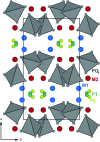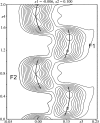Superspace description of wagnerite-group minerals (Mg,Fe,Mn)2(PO4)(F,OH)
- PMID: 24675594
- PMCID: PMC3970752
- DOI: 10.1107/S2052520613031247
Superspace description of wagnerite-group minerals (Mg,Fe,Mn)2(PO4)(F,OH)
Abstract
Reinvestigation of more than 40 samples of minerals belonging to the wagnerite group (Mg, Fe, Mn)2(PO4)(F,OH) from diverse geological environments worldwide, using single-crystal X-ray diffraction analysis, showed that most crystals have incommensurate structures and, as such, are not adequately described with known polytype models (2b), (3b), (5b), (7b) and (9b). Therefore, we present here a unified superspace model for the structural description of periodically and aperiodically modulated wagnerite with the (3+1)-dimensional superspace group C2/c(0β0)s0 based on the average triplite structure with cell parameters a ≃ 12.8, b ≃ 6.4, c ≃ 9.6 Å, β ≃ 117° and the modulation vectors q = βb*. The superspace approach provides a way of simple modelling of the positional and occupational modulation of Mg/Fe and F/OH in wagnerite. This allows direct comparison of crystal properties.
Keywords: modulated structure; superspace; triplite; unified model; wagnerite.
Figures









 displacement as a function of t.
displacement as a function of t.



References
-
- Allen, F., Watson, D., Brammer, L., Orpen, A. & Taylor, R. (2006). International Tables for Crystallography, Vol. C. Berlin: Springer.
-
- Anthony, J. W., Bideaux, R. A., Bladh, K. W. & Nichols, M. C. (2000). Editors. Handbook of Mineralogy, Vol. IV, Arsenates, Phosphates, Vanadates Mineralogical Society of America, Chantilly, VA, USA.
-
- Armbruster, T., Chopin, C., Grew, E. S. & Baronnet, A. (2008). Geochim. Cosmochim. Acta, Suppl. 72, 32.
-
- Bindi, L. (2008). Rend. Lincei, 19, 1–16.
-
- Braitsch, O. (1960). Kali Steinsalz, 3, 1–14.
LinkOut - more resources
Full Text Sources
Other Literature Sources
Miscellaneous

